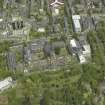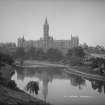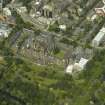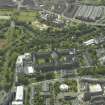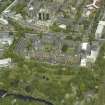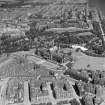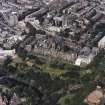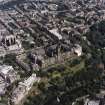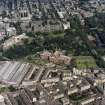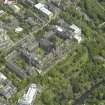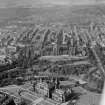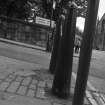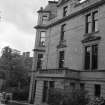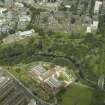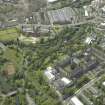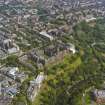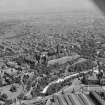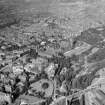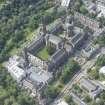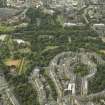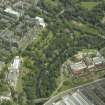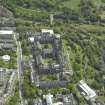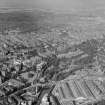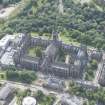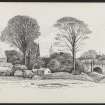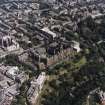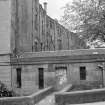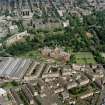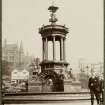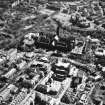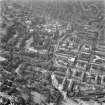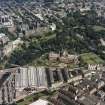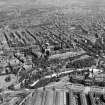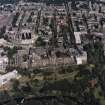Scheduled Maintenance
Please be advised that this website will undergo scheduled maintenance on the following dates: •
Tuesday 3rd December 11:00-15:00
During these times, some services may be temporarily unavailable. We apologise for any inconvenience this may cause.
Glasgow, Glasgow University, General
College(S) (15th Century), University (15th Century)
Site Name Glasgow, Glasgow University, General
Classification College(S) (15th Century), University (15th Century)
Alternative Name(s) Gilmorehill; Kelvingrove; University Of Glasgow
Canmore ID 44119
Site Number NS56NE 54
NGR NS 56916 66655
Datum OSGB36 - NGR
Permalink http://canmore.org.uk/site/44119
- Council Glasgow, City Of
- Parish Govan (City Of Glasgow)
- Former Region Strathclyde
- Former District City Of Glasgow
- Former County Lanarkshire
This is the post-1870 location of the University of Glasgow. See also NS56NE 33.
Architect:
John Baird - new college buildings 1846 - 1847 at Woodland Hill
Prop. Hunterian Museum 1846
Library 1846
Edward Blore 1847 - 1849 - prop new college buildings at Woodland Hill
George Gilbert Scott & J Oldrid Scott 1865 - 1878 - including Bute Hall & Hunterian Museum
Smith & Wharrie 1867 - prop new college buildings
John James Burnet - new college buildings 1868
Sir John Burnet 1895 - Engineering block
Sir John James Burnet 1901 - 1903 - surgical laboratory
MacWhannel & Rogerson 1903 - new medical buildings
Sir John James Burnet 1908 - 1911 - gymnasium
John Burnet & Sons:
1924 - 1930 - prop addition to chapel
1925 Hunter Memorial
1921 - 1923 Natural History Museum
1915 - Tower
1923 - West wing
1923 - Zoology
Archibald Dawson - sculpture
Harold Hughes & D S R Hughes - 1938 Humanity classroom and Reading Room
Alexander Wright 1951 - alterations to Veterinary college
John Keppie & Henderson & J L Gleave 1949 - 1957 - Engineering block
C J McNair, Elder & Ramsay - new arts building 1953
A N Paterson & Stoddart - Students' Union. 2nd prize for design
Alex N Paterson - University Press Office
John Burnet & Lesk - Westerland Pavilion
REFERENCE:
Glasgow University Library Archives
John Burnet & Sons
1924 - 1930 - plans of chapel
1925 - plans for Hunter Memorial
1921 - 1923 - plans for Natural History Museum
1923 - survey of old college stair
1915 - plans for tower
1925 - plans for West wing
1923 - plans for Zoology
Harold Hughes & D R Hughes
1938 - plans for Reading Room and Humanity classroom
John Baird
1846 - 1847 - plans for designs for new college buildings at Woodland Hill
1846 - plans for prop Hunterian Museum
1846 - plans for new library
Edward Blore
1847 - 1849 - plans for designs for new college buildings at Woodland Hill
George Gilbert Scott & J Oldrid Scott
1865 - 1878 - plans for prop new college buildings, Bute Hall & Hunterian Museum
C J McNair, Elder & Ramsay
1953 - plans for new arts building
Sir John Burnet
1895 - 1914 - plans for Engineering block
John Keppie & Henderson & J L Gleave
1949 - 1957 - plans for Engineering
John James Burnet
1868 - plans for new college buildings
Smith & Wharrie
1867 - plans for prop new college buildings
MacWhannel & Rogerson
1903 - plans for new medical buildings
Alexander Wright
1951 - plans for alterations to Veterinary college
A N Paterson & Stoddart
- plans for design for Students' Union
William Inglis
- plans of Students' Union
John Burnet & Lesk
- plans of Westerlands Pavilion
REFERENCE:
Scottish Record Office
Scottish Universities Commission. Memorial and report on the buildings on Glasgow University and a statement of the University Court and Senatus Academicus [printed]
1860 - 1861
GD 220/6/560/31 - 34
National Portrait Gallery
Glasgow and Lanarkshire Illustrated 1910 (Cat 1935 C/July 1946) p5
Publication Account
In 1451 Glasgow Univers ity was founded by a bull of Pope Nicholas V,1 on the application of King James II and Bishop Turnbull . The doctors, masters, readers and students were by this original foundation to enjoy the same privileges and immunities as the University of Bologna, a school of law,2 but in reality the privileges were largely based upon those of St Andrews. The first 'general chapter' was held in the Dominican Chapter-house. Of the thirty-seven members present, all but four appear to •have been cathedral canons and vicars choral.3 Lectures in canon and civil law were conducted in the Dominican Chapter-house, but at the outset only a faculty of arts received a formal constitution. By 1457 it appears that teaching in the arts faculty was conducted in the Auld Pedagogy - a sum of money was contributed from the town's common curse for rental •of the 'pedagogium'. This stood on the south side of Rottenrow.4 Sometime between 1455 and 1460 a tenement and grounds on the east side of High Street, to the north of the premises of the Dominicans, was conveyed to the principal regent in the faculty of arts of the university. Some reversionary interest in the tenement and land seems to have been retained by the bishop, who, therefore, resigned all claims in favour of Lord Hamilton, the possessor prior to conveyance; he thereupon gave valid investiture to the principal regent. Building continued on this site and a few years later further instrucions were given for the construction of a house on the south side of the college on land adjoining the Dominicans' property. In 1467 land to the north of the original grant by Hamilton, extending to the Molendinar, was gifted. The university occupied these sites until its removal to Gilmorehill in 1870.5
Although granted privileges and exemptions from taxation, the university in its earlier years was small and not prosperous. John Major, its principal regent from 1518 and 1532 describes it as ‘poorly endowed and not rich in scholars' . 6 In spite of further financial concessions and the grant of the manse and 'Kirk Room' of the Blackfriars by Queen Mary, 7 the university was still struggling. In 1572-3 the town council, therefore, conveyed to the college most of the lands and church property conveyed to the city by Queen Mary in 1566-8.0 By this same charter a constitution was laid down for the college. The college was to consist of a professor of theology, who was to be principal, with regents (teaching dialectics, physics, ethics and politics), and
twelve poor students. All fifteen were provided for, although there were other students at the college. The appointment of Andrew Melville in 1574 as principal brought ability, renown and consequent prosperity to the college, 9 and further provision was made for the college by the Regent Morton in 1577 which in effect amounted to a new erection and foundation of a university.
In spite of such privileges, which were ratified and granted by James VI in 1587 and Charles I in 1630, it was not until 1632 that a start was made on new buildings on the site at the east of High Street. The major parts were complete by 1656, and the Blackfriars church was recognised as the college chapel. 10 In 1635 it had, however, proved too costly for the university to maintain. An arrangement was entered into whereby the town council took over the church, but paid 2000 perks towards the completion of the college buildings, and the college was to have the next best beats after the town magistrates and the use of the building for all ceremonial occasions. 11 It was destroyed by fire in 1670, but may be seen in Slezer's view of the university in Theatrum Scotiae, published in 1693. Fragments of the 17th century university are now preserved at the new site at Gilmorehill.
Notes
1. Glas. Chrs., i, pt ii, 31-5.
2. Renwick and Lindsay, 215.
3. J Durkan and J Kirk, The University of Glasgow,
1451-1577 (Glasgow 1977) 9.
4. Renwick and Lindsay, 217; Durkan and Kirk, The
University of Glasgow, 1451 - 1577 give full details
on this point and notes (5) to (9).
5. Ibid, 220.
6. Eyre Todd, 85.
7. Ibid, 86.
8. Ibid, 86.
9. Ibid, 90-2.
10. Ibid, 93.
11. Ibid, 98.
In 1870, when the college moved to new premises on Gilmorehill, the college buildings occupied a considerable part of the east High Street frontage between New Vennel and Blackfriars Street and east to Hunter Street. The boundaries of the college property at this time reflect the gradual absorption by gift of adjacent land between the 15th and the mid 19th centuries.
Between 1455 and 1460, the tenement and four acres of land on the north side of the House of Dominican Friars in High Street was resumed from them and conveyed by the owner, James, First Lord Hamilton, to the Principal Regent of the Faculty of Arts in the University, the grant to be perpetuated to his successors. This gift precipitated the transfer of teaching from the 'Auld Pedagogy' in Rottenrow to the new site on the High Street.
No building appears to have taken place on the site at this time, rather the existing tenements were adapted to their new purpose. This initial site was bounded on the south by the property of the Dominican Friars, and on the north by the property of Sir Thomas Arthurlie.
This property, consisting of houses and lands, was conveyed to the University by the owner in 1467. The new permanent northern boundary of the University property from this date was defined from 1666 until 1870 by the south frontage of New Venne]. Arthurlie's gift amounted to two acres, from the Molendinar Burn to the High Street frontage, where the existing tenements were presumably adapted to their new purpose rather that rebuilt.
Further additions were not apparently made to the site until the acquisition of the property of the Dominican Friars by deed of gift from Queen Mary dated 13 July 1563 (MacGregor 1881, 59) This gift included not only the 'manses and kirk rowme' of the Dominican Friars, but thirteen acres (5.2 hectares) of neighbouring land; probably extending south down the High Street frontage to Blackfriars Wynd, and west to the Molendinar.
Information from ‘Historic Glasgow: The Archaeological Implications of Development’, (1990).




















































